Books
Living with Wildlife: How to Enjoy, Cope with, and Protect North America's Wild Creatures Around Your Home and Theirs
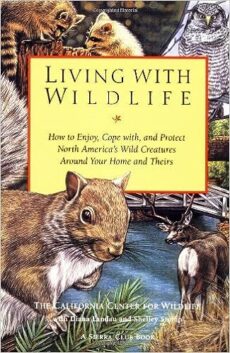
Ever wonder what you should do in an encounter with a bear in your backyard? Or how to prevent woodpeckers from hammering away at your siding, deer from eating your garden, or snakes from taking up residence in your home? This well-researched volume not only answers these questions but also identifies and describes more than 100 North American wildlife species ranging from armadillos to mockingbirds to water snakes. Provided for each animal is information on range, habitat, enemies, and defenses, as well as proven suggestions on how to observe the creature and how to solve in a humane way any problems resulting from human-wildlife interactions. Introductory chapters offer a concise history of wildlife conservation in the United States, suggestions on how to make our homes and our planet more hospitable to wildlife, and advice on what to do when one finds injured, sick, or abandoned animals. An excellent reference for anyone interested in wildlife. Highly recommended. [Lynn C. Badger, University of Florida Library, Gainesville. Library Journal, 1994].
Kids' Easy-to-Create Wildlife Habitats: For Small Spaces in City-Suburbs-Countryside
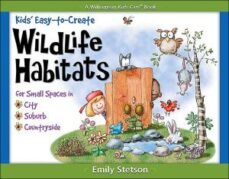
This wide-format book shows children how to observe and support wildlife around their homes, schools, and communities. Packed with useful information, the book discusses characteristics of different animals and qualities that make their habitats suitable for them. It introduces common animals, their habitats, and the foods that attract them. Suggested activities and projects include preparing a feast for butterflies, exploring a rotting log, and making a compost pile. With sound advice and many helpful illustrations, precisely drawn in blue and gray ink, this offers children small ways to support wildlife close to home. [Carolyn Phelan, Booklist].
Wildlife Special Agent: Protecting Endangered Species (Risky Business)
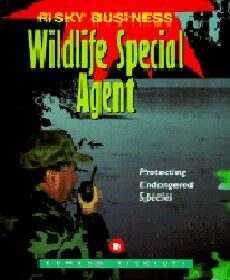
Part of a series that profiles people with careers that might be considered dangerous, this book looks at the division of Law Enforcement of the U.S. Fish and Wildlife Service. It begins with the arrest of a man smuggling illegal rhinoceros horns into the country and then introduces the agent responsible for that arrest. Information is given about the official's different assignments, with particular emphasis on those cases relating to the protection of endangered species, including setting up sting operations to curtail the trafficking of illegal wildlife products. Although the primary focus is on one individual and his work, the book also serves as a good introduction to a part of the government that will be unfamiliar to young readers. In addition to describing an agent's duties, Ricciuti discusses the training process (including how to differentiate between legal and illegal crocodile skins) that is required in order to join the agency. The text is clearly written and informative. Full-color photos appear on almost every page and further serve to illuminate the topic. An interesting look at an unfamiliar occupation that should fascinate both browsers and those searching for an offbeat report topic. [Arwen Marshall, New York Public Library. School Library Journal, 1997].
Pass the Energy, Please
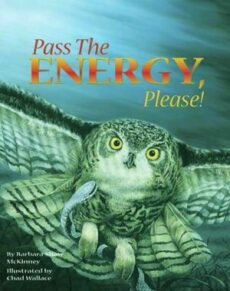
Each of nature's creatures “passes the energy” in its own unique way. In this upbeat rhyming story, the food chain connects herbivores, carnivores, insects and plants together in a fascinating circle of players. All beings on Earth — from the anchovy to the zooplankton — depend upon the green plant, which is the hero of the story. Barbara McKinney's special talent shines again for being able to present the science curriculum so concisely, creatively, and cleverly.
Living With Wildlife in the Pacific Northwest
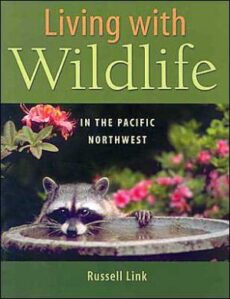
An urban wildlife biologist with the Washington Department of Fish and Wildlife, which co-published the book, Link discusses the mammals, birds, reptiles, and amphibians that ordinary city folk ask about most often; and answers the most frequent questions: whether they are dangerous, how to get rid of them, how to attract and watch them, how to protect them, and how to find out more about them. The illustrations are in black and white.
Wolves (Sierra Club Wildlife Library)

Simon dispels the traditionally negative images of the wolf in this photo essay. Through the appealing full-color photographs and succinct, conversational text, these dynamic, affectionate, and highly intelligent animals are shown to possess many positive traits, such as loyalty, cooperation, and adaptability. A broad range of information is touched upon lightly, including physical characteristics, habitat, hunting and diet, breeding and raising pups, and some unique facts about pack hierarchy and howling. An introduction uses imagery to conjure up the spirit of the wolf; the conclusion touches on the animal's past and questionable future. An attractive and simple introduction, but Candace Savage's Wolves (Sierra, 1989) has more to offer. [Susan Oliver, Tampa-Hillsborough County Public Library System].
Brother Eagle, Sister Sky
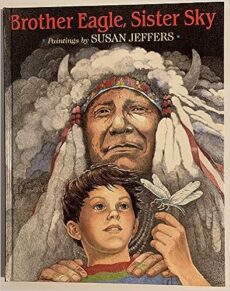
With Native American themes currently in vogue, and environmental awareness a hot issue, this timely picture book scores perfect marks in both arenas. The story is an adaptation of a speech delivered by Chief Seattle at treaty negotiations in the 1850s. Like other great speeches that have stood the test of time, his remarkably relevant message has endured because it comes from the heart and is imbued with passion — here, passion born of love for the land — “This we know: All things are connected like the blood that unites us. / We did not weave the web of life, / We are merely a strand in it. / Whatever we do to the web, we do to ourselves.” Jeffers has paired Seattle's eloquence with her dreamy, meticulous illustrations and the resulting images are haunting. First, readers see Native Americans living in harmony with nature, but gradually the images grow bleaker — ugly swaths of land stripped of their timber. The story comes full circle as a Caucasian family plants new trees on the barren land in a gesture that signifies hope and renewal. Together, Seattle's words and Jeffers's images create a powerful message; this thoughtful book deserves to be pondered and cherished by all. [from Publishers Weekly].
Keepers of the Animals: Native American Stories and Wildlife Activities for Children
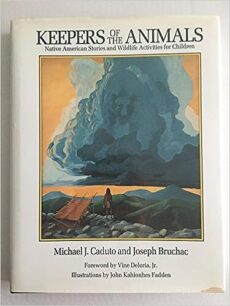
These 24 lovingly told and magically illustrated stories about “our relations, the animals” demonstrate the power and importance of animals in Native American traditions and are more relevant today than ever. As the stories unfold and the activities come to life, a holistic, interdisciplinary approach to Native American attitudes toward animals takes shape. Keepers Of The Animals provides a complete program of study in the important concepts of wildlife ecology and environmental issues concerning animals. The activities have been extensively field-tested and involve children in creative arts, theater, reading, writing, science, social studies, mathematics and sensory awareness. They engage a child's whole self, while emphasizing creative thinking and synthesis of knowledge and experience. Highly recommended for personal, school and public library collections.
